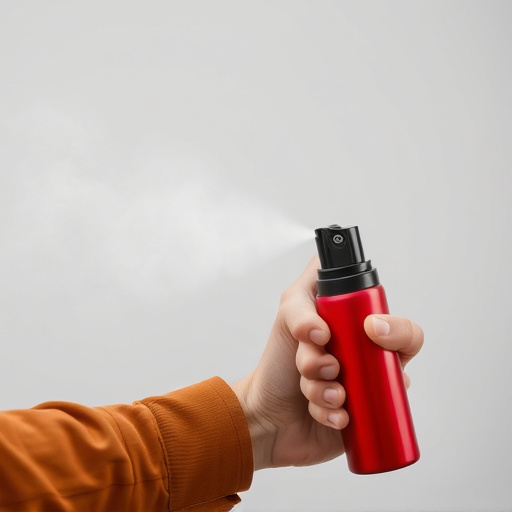Pepper spray serves as a valuable defense mechanism against aggressive dogs for law enforcement, temporarily disabling them via eye and respiratory irritation. Its use requires training, proper targeting (2-3 meters), and de-escalation efforts prior to application, prioritizing public and animal safety while adhering to legal guidelines. Special care is necessary when dealing with dogs due to their limited understanding and mobility.
In today’s diverse urban landscapes, police forces increasingly rely on pepper spray as a crucial tool for crowd control. This article delves into the multifaceted use of pepper spray, focusing specifically on its effectiveness as a defense against dogs. We explore the canine reaction to pepper spray, safe handling techniques, legal considerations, and comprehensive training strategies employed by law enforcement. By understanding these aspects, we can ensure responsible and effective use of this powerful tool in various crowd control scenarios.
- Pepper Spray: Effective Dog Deterrent
- Understanding Canine Reaction to Pepper Spray
- Safe Handling and Deployment Techniques
- Legal Considerations in Crowd Control
- Training Strategies for Police Use of Pepper Spray
Pepper Spray: Effective Dog Deterrent
Pepper spray, a powerful chemical agent, has become an increasingly common tool in crowd control tactics employed by law enforcement agencies worldwide. One of its notable applications is as a defense mechanism against aggressive dogs. During encounters with enraged canines, officers can deploy pepper spray to quickly and effectively subdue the animal, allowing them to gain control over the situation.
The spray creates a burning sensation in the eyes and respiratory system of both humans and dogs, temporarily incapacitating them. This temporary blindness and difficulty in breathing gives police the crucial time needed to either calm down the dog or physically separate it from the potential threat. Moreover, pepper spray is considered a less-lethal option compared to firearms, making it a safer alternative for crowd control situations involving dogs.
Understanding Canine Reaction to Pepper Spray
Pepper spray, often used as a crowd control measure by law enforcement, can also be employed as a defense mechanism against aggressive dogs. When deployed, pepper spray creates an irritant that affects the dog’s eyes, nose, and respiratory system, temporarily disorienting and slowing them down. This provides valuable time for individuals to escape or seek assistance.
However, it’s crucial to understand canine reactions to pepper spray, as their sensitivity varies. Breeds with more sensitive noses, like Chihuahuas or Pugs, might be affected more quickly and intensely than larger breeds. Additionally, the proximity of the spray application matters; direct inhalation can have a more severe impact. Knowing these variables helps individuals use pepper spray responsibly and effectively as a last resort for dog attacks.
Safe Handling and Deployment Techniques
When handling pepper spray designed for crowd control, especially in scenarios involving potential dog aggression, it’s crucial to employ safe techniques. Officers should ensure proper training and understanding of the spray’s properties and effects. This includes knowing the recommended safe distance for deployment, typically between 2-3 meters, to minimize off-target impact on bystanders or animals not posing a threat.
For defense against dogs, pepper spray can be a tactical tool when used appropriately. Techniques should include aiming for the dog’s face and eyes, as this will significantly impair its ability to attack. However, officers must remain vigilant and only deploy the spray as a last resort, when all other de-escalation methods have failed, to ensure both public safety and the welfare of the animal.
Legal Considerations in Crowd Control
When police employ pepper spray as a crowd control measure, legal considerations come into play, especially regarding its use against dogs. While pepper spray can be an effective tool to disperse unruly crowds, its usage must adhere to strict guidelines and regulations, ensuring it doesn’t cause undue harm to non-human entities, including animals.
In many jurisdictions, the use of force, including chemical agents like pepper spray, is subject to proportionality and necessity tests. This means law enforcement officers must assess whether the use of such force is reasonably necessary to maintain public order and whether it’s proportionate to the threat or offense presented. In cases where dogs are involved, special attention should be given to their well-being, as they may not possess the same level of understanding or ability to flee as humans. Thus, police must consider alternative methods and ensure the spray is used responsibly, prioritizing both crowd control and animal safety.
Training Strategies for Police Use of Pepper Spray
Police training on pepper spray use is an essential component of crowd control strategies, especially in situations that involve aggressive animals like dogs. Officers must be equipped with effective techniques to deploy pepper spray while minimizing harm to bystanders and animals. Training programs should focus on teaching officers how to assess a situation, identify potential threats from dogs, and accurately target individuals without endangering innocent lives.
Practical exercises should include simulations of dog interactions, where officers learn to defend themselves and control crowds using pepper spray as a last resort. This includes training in defensive positioning, understanding dog behavior, and the safe application of spray to deter aggressive animals. Additionally, educating the public about responsible pepper spray use can foster a better understanding of its role in crowd control, ensuring public safety while mitigating risks associated with animal attacks.
Pepper spray, while an effective tool for crowd control and dog deterrence, requires careful handling and strategic deployment. Understanding canine reactions, adhering to legal guidelines, and implementing proper training are paramount to ensure its safe and responsible use. By integrating these practices, law enforcement can maximize the effectiveness of pepper spray as a non-lethal force option, thereby enhancing public safety and security in diverse scenarios.
